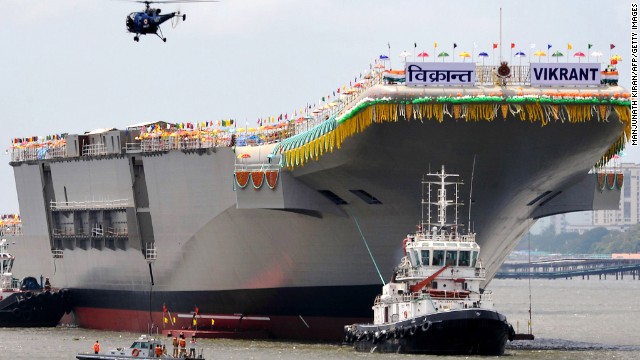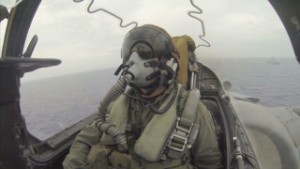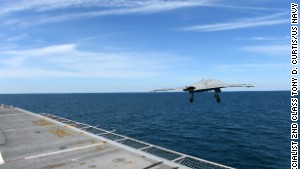Asian superpowers jostle to join the aircraft carrier club
 Tugboats guide aircraft carrier
INS Vikrant as it leaves the Cochin Shipyard after the launch ceremony
in Kochi, India, on Monday, August 12, 2013. India's carrier is
one-third the size of U.S. Navy's Nimitz class carriers.
Tugboats guide aircraft carrier
INS Vikrant as it leaves the Cochin Shipyard after the launch ceremony
in Kochi, India, on Monday, August 12, 2013. India's carrier is
one-third the size of U.S. Navy's Nimitz class carriers.
Asian aircraft carrier race
- China, India and Japan have turned to aircraft carriers as an extension of military prestige
- Aircraft carriers are expensive to build, logistically complex to operate and costly to defend
- Carrier race comes amid rising assertiveness of Asian's military powers
- Military analysts say the value of a carrier lies in having one rather than using one
In China, a retro-fitted former Ukrainian carrier
dating back to the Soviet era is the flagship of the country's hopes
for a "blue water" navy -- a fleet that can operate on the high seas
thousands of nautical miles from base. India has launched its first home
built aircraft carrier as part of a plan to operate three carrier
battle groups by 2020.
And Japan -- whose navy is officially classed as a self-defense force -- has controversially unveiled what it has classed as a flat-topped helicopter destroyer, but to China looks perilously akin to an aircraft carrier.
This latest piece of
must-have military hardware might be expensive to build, logistically
complex to operate and costly to defend -- and in the context of drone
and submarine technology, some argue, increasingly obsolete - but the
aircraft carrier is still regarded as one of the strongest projections
of a nation's military power.
More image than action?
The carrier race comes amid rising assertiveness of Asian's military powers and changing conditions in the region.
 China lands jet on aircraft carrier
China lands jet on aircraft carrier
 Modern Nato shows strength
Modern Nato shows strength
 Watch first drone launch from carrier
Watch first drone launch from carrier
For Japan, it's a counter
to the rising power of China and the threat from North Korea. For
India, its carrier flexes its muscle in the direction of Pakistan while
China wants to project power along its trade routes and regional
interests.
Just 20 aircraft carriers
are active throughout the world and the U.S. Navy operates 10 of them.
For many military analysts, however, the value of a carrier lies in
having one rather than ever using one.
Ashley Townshend, analyst
with the Lowy Institute for International Policy, says there is a
disconnect between what an aircraft carrier projects and what it can
actually do.
"Needing an aircraft
carrier and wanting one are two different things," Townshend told CNN,
adding that Asia -- despite recent headlines -- has had a long history
of aircraft carrier operation.
"India has operated
carriers before; China hasn't but China is a new foray into carrier
naval warfare/carrier naval operations," he said. "Japan interestingly
had the world's first aircraft carrier."
Costly carrier
As an indication of how
much a carrier costs, Britain is plowing an estimated £5 billion (US$8
billion) into its new carrier Queen Elizabeth. It is so large that it is
being constructed in sections at six shipyards around the United
Kingdom before being slotted together at Rosyth in Fife, Scotland.
Perhaps fittingly for
China's biggest naval gamble, its refurbished Ukrainian carrier was once
touted to become a casino in Macau, a Special Administrative Region
(SAR) of China and a gambling center.
"This is really its
initial training platform," said Townshend. "It's unlikely that this
carrier would be able to pack the sort of punch that would make it
useful as a power projection carrier outside of limited and asymmetric
incidents in Asia.
"You could conceivably
ship it down into the South China Sea for the purposes of intimidating
weaker South East Asian nations -- but that carries with it a lot of
risks not least the proliferation of anti-carrier anti-sea control
platforms in Asia."
Vulnerable
He said submarines,
ship-launched and land-based ballistic missiles all make aircraft
carriers vulnerable to attack in the context of modern conventional
warfare.
"The sort of things,
interestingly, that China has been building to keep the U.S. out of the
Taiwan Strait are also being built by South East Asian nations to keep
large scale Chinese naval platforms from being as powerful as they might
be in the region."
Needing an aircraft carrier and wanting one are two different things
Ashley Townshend
Ashley Townshend
While India, China and
Japan may have deep pockets, the technology and military infrastructure
necessary to operate what amounts to a floating military city for
thousands of personnel still lags among these Asian superpowers.
Military analyst Michael Horowitz, associate professor of political science at the University of Pennsylvania, in his book The Diffusion of Military Power, says learning to operate an aircraft carrier is difficult and time-consuming
"Carrier warfare is one
of the only major military innovations requiring high levels of both
financial intensity and organizational capital to adopt," he said.
"Operating a floating airfield and the ship itself, plus coordinating
with support ships, is simply a much harder set of tasks than lining up
the big guns of a battleship and firing."
Carrier losses
Aircraft carriers also have one of the highest attrition rates of any arm of the military. According to a study by Professor Robert Rubel of the U.S. Naval War College, between 1949 and 1988 the US Navy and Marine Corps lost 12,000 aircraft and 8,500 air crew.
Analysts say that with China training less than 100 pilots to operate fixed-wing aircraft from carriers, its capacity to absorb losses is low.
"It's difficult to train
pilots up to land on what is effectively a moving airfield," Townshend
said. "While China will learn from the successes and failures of every
country that has gone before it, it does take a lot of time and China
has less than 100 airmen who are being trained to fly their version of a
carrier aircraft."
Meanwhile, as India and
China size up each other in the carrier war, analysts say it has to be
remembered that both carrier nations have ships that are a third the
size of the U.S. Nimitz class ships.
"For the Chinese, a lot
of it is tied up with a story about itself becoming a great power,"
Townshend said. "For China to be a great power it must be a great
maritime power and to be a great power it must have carriers and blue
water naval platforms."

No comments:
Post a Comment